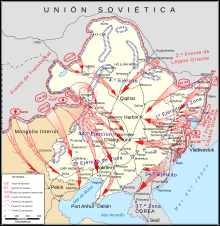Soviet invasion of Manchuria

The Soviet invasion of Manchuria, formally known as the Manchurian strategic offensive operation or simply the Manchurian operation, began on 9 August 1945 with the Soviet invasion of the Japanese puppet state of Manchukuo. It was the largest campaign of the 1945 Soviet-Japanese War, which resumed hostilities between the Union of Soviet Socialist Republics and the Empire of Japan after almost six years of peace. Since 1983, the operation has sometimes been called Operation August Storm.
Soviet gains on the continent were Manchukuo, Mengjiang (now Inner Mongolia) and northern Korea. The Soviet entry into the war and the defeat of the Kwantung Army was a significant factor in the Japanese government's decision to surrender unconditionally, as it made apparent the Soviet Union had no intention of acting as a third party in negotiating an end to hostilities on conditional terms.
Quotes
[edit]- The Japanese had expected a Soviet offensive into Manchuria but believed that it could not begin before autumn. The August 9 assault not only surprised them, but also caught them in the process of reorganizing their defenses and units. The result was massive victory by the Soviets, despite fierce and dedicated resistance by many Japanese units.
- Based on proven capabilities of the Japanese High Command and the individual Japanese soldier, Soviet plans were as innovative as any in the war. Superb execution of those plans produced victory in only two weeks of combat. Although Soviet. planners had overestimated the capabilities of the Japanese High Command, the tenacious Japanese soldier met Soviet expectations. He lived up to his reputation as a brave, self-sacrificing samurai who, though poorly employed, inflicted 32,000 casualties on the Soviets and won their grudging respect. Had Japanese planners been bolder-and Soviet planners less audacious-the price of Soviet victory could well have been significantly higher.
- David Glantz, August Storm: The Soviet 1945 Strategic Offensive in Manchuria (Leavenworth Papers, Number 7), p.14 (1983)
- Operation August Storm was a colossal undertaking, pitching 1.6 million Soviet troops against 1 million Japanese. Historians continue to debate whether it, rather than the atomic bombings, holds primary claim in compelling Japan to finally surrender on August 15.
- Andrew Salmon, "Red storm on Rising Sun" in Asia Times (11 August 2020)
- By August 1945, war weariness, overwhelming odds, and sheer self-preservation exerted countervailing pressures to the indoctrination. While they did fight hard at the outset of August Storm, Japanese soldiers eventually capitulated in droves to the Soviets.
External links
[edit] Encyclopedic article on Soviet invasion of Manchuria on Wikipedia
Encyclopedic article on Soviet invasion of Manchuria on Wikipedia Media related to Soviet invasion of Manchuria on Wikimedia Commons
Media related to Soviet invasion of Manchuria on Wikimedia Commons
